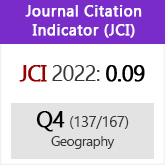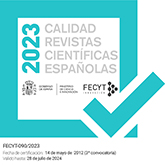Cambios en la distribución de cultivos y producciones ganaderas en España inducidos por la nueva PAC
DOI:
https://doi.org/10.3989/estgeogr.0431Palabras clave:
Política Agraria Comunitaria, modelos de explotaciones representativas, sector agrario español, distribución de cultivos y ganadoResumen
En este trabajo se analiza el impacto sobre el sector agrario español de las medidas de la Política Agraria Común de desacoplamiento de ayudas directas a las superficies sembradas de distintos cultivos y a las cabezas de ganado.
El análisis se hace en base a los datos de 2002 de la Red Contable Nacional Agraria y a los resultados simulados para 2013 con el modelo de programación matemática PROMAPA, utilizando la predicción de variacion de precios entre 2002 y 2013 del modelo europeo de simulación ESIM.
Los resultados obtenidos permiten comparar los cambios en la distribución de cultivos y de distintas categorías de ganado entre el año base 2002 y el año simulado, 2013, según se siga una política de desacoplamiento parcial, como la implantada en España en 2006, o una política de desacoplamiento total sobre la que se está reflexionando actualmente.
En este trabajo se comparan, por otra parte, los cambios que se observan con los dos tipos de desacoplamiento con los que se obtendrían en el caso de proseguir las medidas vigentes en 2002 en el contexto de la denomina Agenda 2000.
Descargas
Citas
Adenáuer, M.; Britz, W.; Gocht, A.; Gömann, H.; Cristoiu, A. y Ratinger, T. (2006): Modelling impacts of decoupled premiums: building-up a farm type layer within the EU-wide regionalised CAPRI model, Selected paper presented at the 93rd EAAE Seminar, Praga, 22-23 septiembre.
Arfini, F. y Paris, Q. (1995): “A positive mathematical programming model for regional analysis of agricultural policies”, en Sotte, E., The Regional Dimension in Agricultural Economics and Policies, EAAE, Proceedings of the 40th Seminar, 26-28 junio, pp. 17-35.
Arriaza, M. y Gómez-Limón, J. A. (2003): “Comparative performance of selected mathematical programming models”, Agricultural Systems, nº 77, pp. 155-171.
Barkaoui, A. y Butault, J. P. (1999): Positive Mathematical Programming and Cereals and Oilseeds Supply within EU under Agenda 2000, Paper presented at the 9th European Congress of Agricultural Economics, Varsovia, agosto.
Barkaoui, A. y Butault, J. P. (2003): Révision à mi-parcours de la PAC : simulations de l’effect du découplage sur l’offre dans les régions françaises, Document de travail, INRA-ESR Nancy.
Blanco, A. e Iglesias, E. (2005): Modelling New EU Agricultural Policies: Global Guidelines, Local Strategies, Selected paper presented at the 89th EAAE Seminar, 3-5 febrero, Parma.
Buysse, J.; Fernagut, B.; Harmignie, O.; Henry De Frahan, B.; Lauwers, L.; Polomé, P.; Van Huylenbroeck, G. y Van Meensel, J. (2004): Modelling the impact of sugar reform on Belgian Agriculture, Selected paper presented at the International Conference on Policy Modelling, París, 30 junio-2 julio.
Buysse, J. y Van Huylenbroeck, G. (2005): Impact of alternative implementations of the Agenda 2000 Mid Term Review, Selected Paper presented at the 11th Congress of the EAAE, Copenhague, Dinamarca, agosto 24-27.
Buysse, J.; Van Huylenbroeck, G. y Lauwers, L. (2007): “Normative, positive and econometric mathematical programming as tools for incorporation of multifunctionality in agricultural policy modelling”, Agriculture, Ecosystems & Environment, 120, pp. 70-78.
CAPRI (2000): Common Agricultural Policy Regional Impact (Fair3-CT96-1849), Final Consolidated Report, Institute for Agricultural Policy, University of Bonn, Department of Economics, University College Galway, Institut Agronomique Meditérranéen de Montpellier, Departamento di Economia, Sociologia y olitica Agraria, Universidad Politécnica de Valencia, Università degli Studi di Bologna, Dipartamento di Protezione e Valorizzazione Agro-Alimentare (DIPROVAL), Sezione Economía.
Gohin, A. y Chantreuil, F. (1999): “La programmation mathématique positive dans les modèles d’exploitation agricole: principes et importance du calibrage”, Cahiers d’Économie et Sociologie Rurales, nº 52, pp. 59-78.
Hazell, B. R. y Norton, R. D. (1986): Mathematical Programming for Economic Analysis in Agriculture, McMillan, Nueva York.
Heckelei, T. y Britz, W. (1999): Maximum entropy specification of PMP, CAPRI Working Paper 08199, en: http://www.agp.uni-bonn.de/agpo/rsch/capri/wrkpap-e.htm
Heckelei, T. y Wolff, H. (2003): “Estimation of Constrained Optimisation Models for Agricultural Supply Analysis Based on Generalised Maximum Entropy”, European Review of Agricultural Economics, nº 30(1), pp. 27-50.
Heckelei, T. y Britz, W. (2005): Models Based on Positive Mathematical Programming: State of the Art and Futher Extensions, Plenary paper presented at the 89th EAAE Seminar, 3-5 febrero, Parma, pp. 48-73.
Helming, J. F. M.; Peeters, L. y Veendendaal, P. J. J. (2001): “Assessing the Consequences of Environmental Policy Scenarios in Flemish Agriculture”, en Heckelei, T.; Witzke, H. P. y Henrichsmeyer, W. (eds.), Agricultural Sector Modelling and Policy Information Systems, Vank Verlag, Kiel.
Henry de Frahan, B. (2005): PMP, Extensions and Alternative Methods: Introductory Review of the State of the Art, Selected Paper presented at the 11th Congress of the EAAE, Copenhague, Dinamarca, agosto 24-27.
Howitt, R. E. (1995): “Positive Mathematical Programming”, American Journal of Agricultural Economics, nº 77(2), pp. 329-342.
Ibáñez J. y Pérez C. (1999): “Impactos de la Reforma de la PAC de 1992 sobre el subsector agrícola español”, Revista de Estudios Agrosociales y Pesqueros, nº 185, pp. 9-30.
Jayet, P. A.; Marzochi, E.; Hofstetter, A. y Donati, M. (2000): Modular approach of agricultural supply modelling through linear programming, EUROTOOLS, Working Paper, Series nº 26.
Jayet, P.A. (ed.) (2007): Policy Recommmendation, Work Package 7, Deliverable D10, GENEDEC, Project 502184.
Júdez, L.; Martínez, S. y Fuentes-Pila, J. (1998): Positive Mathematical Programming Revisited, Trabajo presentado al meeting de Madrid, 16-17 de octubre sobre EUROTOOLS (Proyecto FAIR 5-CT97-3403).
Júdez, L.; Chaya, C.; Martínez, S. y González, A. A. (2001): “Effects of the Measures Envisaged in ‘Agenda 2000’ on Arable Crop Producers and Beef and Veal Producers: An Application of Positive Mathematical Programming to Representative Farms of a Spanish Region”, Agricultural Systems, nº 67, pp. 121-138.
Júdez, L.; De Miguel, J. M.; Piniés, M.; Legorburu, I. G. y Miguel, J. L. (2004): Effects of Mid-Term review measures on some representative Spanish farm: an application of the PROMAPA model, Selected paper presented 80th EAAE Seminar, Ghent, 24-26 septiembre.
Júdez, L.; De Andrés, R.; Ibáñez, M.; De Miguel, J. M. y Urzainqui, E. (2005): The PROMAPA. G Model, Document of GENEDEC Project, 31 marzo.
Kuepker, B. y Kleinhanss, W. (2006): Comparative Assessment of National and Alternative Decoupling Schemes in EU Member States, Selected paper presented at the 93 rd EAAE Seminar, Praga 22-23 septiembre.
Offermann, F.; Kleinhanss, W.; Huettel, S. y Kuepker, B. (2005): “Assessing the 2003 CAP reform impacts on German Agriculture using the farm group model FARMIS”, en Arfini, F. (ed.), Modelling agricultural policies: state of the art and new challenges, Proceedings of the 89th EAAE Seminar, Parma.
Osterburg, B.; Offermann, F. y Kleinhanss, W. (2001): “A sector consistent farm group model for German agriculture”, en Heckelei, T.; Witzke, H. P. y Henrichsmeyer, W. (eds.), Agricultural Sector Modelling and Policy Information Systems, Kiel, Wissenschaftsverlag, Vauk.
Paris, Q. y Howitt, R. E. (1998): “An Analysis of Ill-posed Production Problems Using Maximum Entropy”, American Journal of Agricultural Economics, nº 80(1), pp. 124- 138.
Paris, Q.; Montresor, E.; Arfini, F. y Mazzocchi, M. (2000): An Integrated Multi-Phase Model for Evaluating Agricultural Policies Through Positive Information, en Heckelei, T.; Witzke, H. P. y Henrichsmeyer, W. (eds.), Agricultural Sector Modelling and Policy Information Systems, Proceedings of the 65th EAAE Seminar, marzo 29-31, Bonn University, Vauk Verlag Kiel, pp. 100-110.
Röhm, O. y Dabbert, S. (1999): “Modelling regional production and Income Effects”, en Huylenbroeck, G. y Witby, M. (eds.), Countryside Stewardship, Farmers, Policies and Markets, Pergamon, Ámsterdam.
Röhm, O. y Dabbert, S. (2003): “Integrating Agri-Environmental Programs into Regional Production Models: An Extension of Positive Mathematical Programming”, American Journal of Agricultural Economics, nº 85(1), pp. 254-265.
Descargas
Publicado
Cómo citar
Número
Sección
Licencia
Derechos de autor 2008 Consejo Superior de Investigaciones Científicas (CSIC)

Esta obra está bajo una licencia internacional Creative Commons Atribución 4.0.
© CSIC. Los originales publicados en las ediciones impresa y electrónica de esta Revista son propiedad del Consejo Superior de Investigaciones Científicas, siendo necesario citar la procedencia en cualquier reproducción parcial o total.Salvo indicación contraria, todos los contenidos de la edición electrónica se distribuyen bajo una licencia de uso y distribución “Creative Commons Reconocimiento 4.0 Internacional ” (CC BY 4.0). Puede consultar desde aquí la versión informativa y el texto legal de la licencia. Esta circunstancia ha de hacerse constar expresamente de esta forma cuando sea necesario.
No se autoriza el depósito en repositorios, páginas web personales o similares de cualquier otra versión distinta a la publicada por el editor.
















